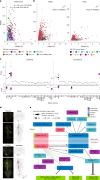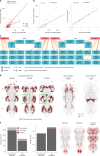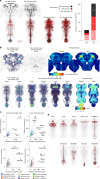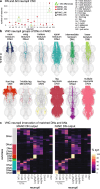Comparative connectomics of Drosophila descending and ascending neurons
- PMID: 40307549
- PMCID: PMC12222017
- DOI: 10.1038/s41586-025-08925-z
Comparative connectomics of Drosophila descending and ascending neurons
Abstract
In most complex nervous systems there is a clear anatomical separation between the nerve cord, which contains most of the final motor outputs necessary for behaviour, and the brain. In insects, the neck connective is both a physical and an information bottleneck connecting the brain and the ventral nerve cord (an analogue of the spinal cord) and comprises diverse populations of descending neurons (DNs), ascending neurons (ANs) and sensory ascending neurons, which are crucial for sensorimotor signalling and control. Here, by integrating three separate electron microscopy (EM) datasets1-4, we provide a complete connectomic description of the ANs and DNs of the Drosophila female nervous system and compare them with neurons of the male nerve cord. Proofread neuronal reconstructions are matched across hemispheres, datasets and sexes. Crucially, we also match 51% of DN cell types to light-level data5 defining specific driver lines, as well as classifying all ascending populations. We use these results to reveal the anatomical and circuit logic of neck connective neurons. We observe connected chains of DNs and ANs spanning the neck, which may subserve motor sequences. We provide a complete description of sexually dimorphic DN and AN populations, with detailed analyses of selected circuits for reproductive behaviours, including male courtship6 (DNa12; also known as aSP22) and song production7 (AN neurons from hemilineage 08B) and female ovipositor extrusion8 (DNp13). Our work provides EM-level circuit analyses that span the entire central nervous system of an adult animal.
© 2025. The Author(s).
Conflict of interest statement
Competing interests: H.S.S. declares a financial interest in Zetta AI. L.S.C. declares a financial interest in Aelysia. The remaining authors declare no competing interests.
Figures



















References
-
- Takemura, S.-Y. et al. A connectome of the male Drosophila ventral nerve cord. eLife13, 10.7554/eLife.97769.1 (2024).
Publication types
MeSH terms
Grants and funding
LinkOut - more resources
Full Text Sources
Molecular Biology Databases

